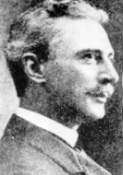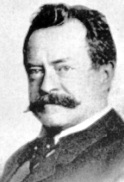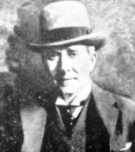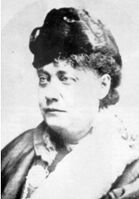95...
THE “HIRAF” CLUB AND ITS HISTORICAL BACKGROUND
[Mention has already been made of the names of William M. Ivins and William S. Fales, two attorneys at law who represented H.P.B. in her court-case at Riverhead, Long Island, N. Y. As these two individuals, together with several of their friends, played an important part in H.P.B.’s literary activity at its very inception, the following excerpt from the work of Charles R. Flint, Memories of an Active Life, from which we already had occasion to quote, will be of interest to the reader. Mr. Flint writes:
96 “For several years I was a member of the Philologian Debating Society of the Brooklyn Polytechnic, and out of this organization grew what was probably the most extraordinary secret body the world has ever known. Among the members of the Philologian were Dr. Henry Van Dyke, the famous author; Charles F. Chichester, who became Treasurer of the Century Company; Frederick W. Hinrichs, the political reformer; and William E. S. Fales, who was regarded by everyone as a man of genius.
“None of his friends can ever forget Fales, the many-sided, with his massive head and his blond curls, his high, broad forehead and square jaw, deep chest and steel muscles. Six feet of splendid physical manhood, he loved to display his powers and often exhibited his mountainous biceps. But though he might have excelled as an athlete, his herculean strength was more than equalled by his wonderful mental equipment. Books had been his friends from childhood, and he loved to ‘ponder over many a quaint and curious volume of forgotten lore.’ Research, a natural flow of language, a brilliant fancy, and a glowing imagination, led him naturally to literary composition.
“Like champagne, he was often effervescent, sparkling, and overflowing. Much that he emitted was like froth, but much, too, was substantial and weighty. He even had his periods of gloom. He would deliver a talk on the history of Satan, and follow it with a paper on the origin of obscene words. This, in turn, would be succeeded by a lugubrious poem on death, or on the final ‘wreck of matter and the crash of worlds.’ While in addition to exercising his skill in the realm of the imagination, he was addicted to mathematics and scientific research.
“But despite his gifts, Fales lacked purpose and the will for sustained effort. He was conscious that he could surpass most men if he cared to exert himself. This circumstance, as in the case of the hare and the tortoise, frequently caused his failure, a duller competitor securing the victory.
“He often said that life was a joke and he generally appeared to make this epigram the maxim of his career. Thus, while he was recognized by his fellows in the Columbia School of Mines, as the most brilliant mathematician that school had ever had, and as a student who in less time than any other could accomplish a given task, after leading his class in the first year he fell to the middle in the second year, and failed of graduation in the third. An enraged father sent him to Brazil to follow a business career. Tiring of that after a year’s absence, he returned to New York and to Columbia, where he passed his examinations and received his degree after a very
96.1



(The two upper photographs are from Charles R. Flint’s Memories of an Active Life, New York and London, 1923. The portrait of W. M. Ivins is from The National Cyclopaedia of American Biography, Vol. XXX. Consult pp. 95-100, and the Bio-Bibliographical Index for biographical data.)
96.2

97
brief period of study. From the School of Mines he went to the School of Law. Indeed, there is little that he did not attempt.
“For a while he taught 8 class of small boys at a Sunday School, and he filled their pockets with—cigars. He challenged a missionary to compete with him in a petition to Heaven. He lacked reverence, absolutely.
“He was a great debater; but quite conscienceless, for he would volunteer on either side of a controversy, whatever his opinion as to the real merits of the question. There seemed to be no subject upon which he was unprepared to speak interestingly and with effect.
“It seemed to his associates in the Milton Literary Association that there was no height to which he might not have climbed, had he been governed by a high purpose. Hinrichs has preserved many of Fales’ letters. These two men were different in their ideals, but each had the warmest affection for the other. Fales had a big heart, and much is pardoned one who is generous.
“In 1868 the Milton Literary Association was organized and with this association the Philologian Society was merged. Its incorporators were A. Augustus Healy—for many years President of the Brooklyn Institute of Arts and Sciences—myself, and other members of the Philologian Society.
“For six years the Milton Association met weekly in the rooms of the Hamilton Literary Society, of which Seth Low was the most prominent member, and which subsequently became the Hamilton Club. The Milton was an exclusive society, no one being admitted until he had been pronounced intellectually fit by an unanimous vote of the members. In its conceit, it black-balled no less a personage than Hon. William M. Ivins who was afterwards generally regarded as one of the most brilliant men in the city of New York, and who, at a later period, was admitted to the membership of the Milton. We debated all questions concerning the heavens above, the earth beneath, and the waters under the earth.
“After six years the Miltonians became engrossed in professional and business affairs and the meetings of the Association were discontinued, but reunion dinners were held every few years. At one of these reunions Ivins arose, and to the surprise of all, disclosed the existence of an organization named ‘Hiraf,’ which, he said, had been created more than thirty-five years before, ‘for the purpose of testing human credulity!’ The name ‘Hiraf’ was an acrostic made up of the first letters of the names of five Miltonians.
“H stood for Frederick W. Hinrichs, the man who probably ran for more important public offices, without being elected, than any man in the United States. In 1896 he ran for 98 Lieutenant-Governor of New York on the Gold Democratic ticket; in 1897 for President of the Borough of Brooklyn, on the Seth Low Fusion ticket; in 1898 for Attorney-General of the State of New York, on a Citizens’ ticket which was to have been headed by Theodore Roosevelt; in 1903 for Comptroller of the City of New York, on a Fusion ticket, headed by Seth Low for mayor. In 1904, he was nominated for Governor of New York by a faction of the Democratic Party, and the nomination was seconded by his brother Miltonian, A. Augustus Healy. He is generally known for his independent speech and his consistent opposition to political machines.
“I stood for William M. Ivins, who was one of the ablest lawyers in New York. He became City Chamberlain, and was one of the leaders who brought about the adoption of the secret ballot. Governor Charles T. Hughes appointed him chairman of a charter commission, and he was most active in drawing a proposed new charter for Greater New York—which a prominent politician told me was ‘the best charter that could have been drawn for the people, but the worst for the politicians, and, therefore, would never be adopted.’ At the request of Governor Hughes, Ivins drew the laws under which the public utilities commissions have been appointed. On behalf of the City he acted as counsel in the investigations of Tammany Hall; and he also ran for Mayor of New York City.
“R stood for James C. Robinson, whose part in the activities of the ‘Hiraf’ is evidenced by a letter which I will quote on a succeeding page.
“A stood for Charles Frederick Adams, an able and learned lawyer practicing in New York.
“F stood for William E. S. Fales.
“That evening we learned from Ivins that the ‘Hiraf’ in its efforts to test human credulity and to contribute to behavioristic psychology, conceived the idea of sending an article to a Boston magazine, the Spiritual Scientist, which was one of the most important spiritistic publications in the United States. The article was prepared by four members of the ‘Hiraf,’ who without consultation with one another, wrote psychic and esoteric sentences which were transmitted to Fales, who was known as the ‘conjunctor,’ and whose duty it was to combine into a more or less consistent whole the efforts of the various contributors . . . . . .
“Although the ‘Hiraf ’ article was written by young men upon the threshold of their careers, partly as an exercise in mental 99 gymnastics, or even as a literary hoax, nevertheless we must be struck by the fact that recent advances in science and some of the arts make us believe that the time is not far distant when some of the dreams and visions which have been entertained by theologians, philosophers, and prophets in the past may be realized.
“. . . . . parties interested in the theosophic movement have insisted that whatever the origin of the ‘Hiraf’ utterances may have been, the authors were, without their knowledge, inspired, by a power over and beyond them, to utter words of weight and possibly prophecy.
“Whatever adverse opinion may still be entertained as to Madame Blavatsky and her cult, it cannot be denied that her teachings contain much that is interesting, even elevating, and that she has managed to affect many, many thousands, from India in the east to California in the west.”[1]
Further details concerning this matter may be gathered from a letter written by Frederick W. Hinrichs to C. Jinarâjadâsa, dated from 140 Liberty Street, Manhattan, New York, May 2, 1923, and which is now in the Adyar Archives. Mr. Hinrichs says:
“. . . . The writers of the ‘Hiraf’ article are William M. Ivins, William E. S. Fales and myself. There were two others of our number who took a lively interest in our philosophic and theological discussions,—but they contributed little or nothing to the production. One was Charles F. Adams,—the other James Robinson. Of the group of five, all are dead but myself. The name ‘Hiraf’ was made up of the initial letters of our five names. I always thought that Adams had contributed some portion of the essay,—but, shortly before his death, in reading over the article with me, he said that he could not recognize that any part of it was his. All of us were young lawyers at the time, or students of the law, with exception of Robinson, who was a clerk in a commercial concern. Fales received the fragments prepared by Ivins and myself and, together with his own contribution, welded the three into one. Fales, Ivins and I wrote without consultation with one another on such topics as suggested themselves to us, after we separated one evening. We five often met at the house of Fales (a many-sided genius) to read, to discuss literature, especially philosophic literature, and cognate matters . . . .
100 “. . . . We young men had little reverence, some learning and some power of expression, and, at the meeting referred to, jocularly suggested to one another the writing of a mystic article on Theosophy, esoteric science and what not. I had been reading Zanoni, a book on Rosicrucianism, and the life of Paracelsus,—so that I wrote, especially, along those lines. The Madame [H.P.B.] claimed to be a Rosicrucian and, when Fales received my contribution and Ivins’ contribution (this latter on recent phases of philosophical thought), he (Fales), without any consultation with either Ivins or myself, dubbed the article, which he compounded out of our three or four separate unrelated contributions—‘Rosicrucianism.’ Fales also created the acrostic ‘Hiraf’ out of our initials, and added five stars, probably suggested by three stars appended to an article which has previously appeared in the Madame’s paper. We all laughed heartily over the compounded article and sent it to the Madame in Boston. She published it in two numbers of her periodical, as I recall it, and wrote two very flattering editorials on ‘Hiraf.’ Our production provoked considerable comment, and called forth some correspondence from different widely separated quarters, some of which correspondence appeared in the Madame’s paper.
“I have been told by Theosophists here, that we young men had written better than we knew, and that we were probably inspired by higher powers. Of this, I know nothing, although this may be so. Certain it is, that ‘Hiraf’ has been quite extensively quoted as authority in various printed publications . . . .”
Such were the curious circumstances which provided the background to the publication of the article entitled “Rosicrucianism” in the Spiritual Scientist, Vol. II, July 1 and 8, 1875, pp. 202 and 212-13 respectively.
A brief item from the pen of Colonel Olcott introduced the “young author” to the reading public in rather laudable terms, and promised a reply from “a most competent hand.”
The article drew from H.P.B. an immediate reply which was her first major contribution on the subject of Occultism, a literary production which she herself called “My first Occult Shot.” The text of this reply, in the words of Col. Olcott (Old Diary Leaves, I, 103), “laid open the whole field of thought since ploughed up by the members, friends, and adversaries of the Theosophical Society.” —Compiler.]
Footnotes
- ↑ C. R. Flint, Memories of an Active Life, pp. 115-32.